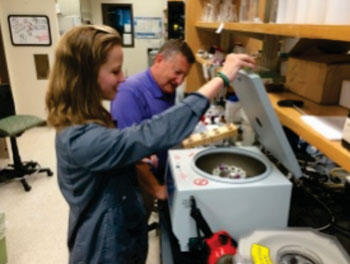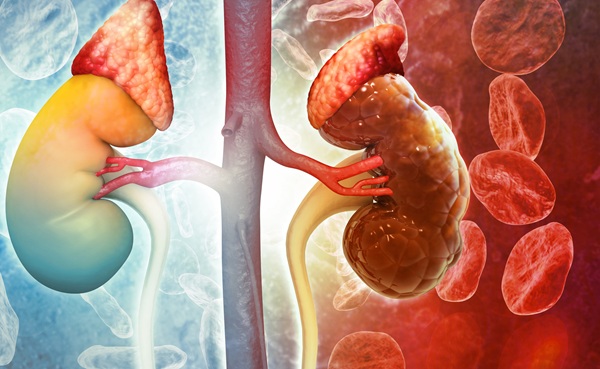Rapid Extraction Technique Prepares Urine Samples for Mass Spectrometry Analysis
|
By LabMedica International staff writers Posted on 07 Jun 2015 |

Image: The centrifugation step is the key to removing protein biomarkers from urine\'s high salt matrix (Photo courtesy of Clemson University).
Disposable mini-tubes packed with capillary-channeled polymer (C-CP) fibers have been adapted for the rapid extraction of proteins from urine specimens for analysis by MALDI-MS (matrix-assisted laser desorption/ionization mass spectrometry).
While mass spectrometry is a powerful tool for biomarker determinations, the high salt content and the matrix of small molecules present in urine has reduced its applicability for urinary diagnosis. To correct this deficiency, investigators at Clemson University (SC, USA) packed micropipette tips with C-CP fibers. These fibers possess a unique geometry that includes eight channels that extend the entire fiber length (which can be miles on a spool). The fibers are nominally an oblong shape with diameters ranging from 35 to 50 micrometers, with the individual channels ranging in size from five to 20 micrometers.
Urine samples were passed through fiber-packed tubes by spinning them in a centrifuge for 30 seconds. Following centrifugation de-ionized water was run through the tubes for one minute to wash off salt and other contaminants. Hydrophobic proteins, which remained bound to the fibers, were extracted for MALDI-MS analysis with appropriate solvents during a 30 second centrifugation step.
Matrix-assisted laser desorption/ionization (MALDI) is a soft ionization technique used in mass spectrometry, allowing the analysis of biomolecules (biopolymers such as DNA, proteins, peptides, and sugars) and large organic molecules (such as polymers, dendrimers, and other macromolecules), which tend to be fragile and fragment when ionized by more conventional ionization methods. It is similar in character to electrospray ionization (ESI) in that both techniques are relatively soft ways of obtaining ions of large molecules in the gas phase, though MALDI produces far fewer multiply charged ions.
The C-CP fiber method was validated by measuring the urinary proteins beta-2-microglobulin, retinol binding protein, and transferrin. C-CP fiber tips offered several advantages including low materials costs, high throughput, microvolume processing, and the determination of sub-nanogram quantities of analyte; allowing determination of biomarkers that are otherwise undetectable in urine samples.
"You have got almost seawater coming out of you, and I am trying to find something far smaller than a needle in a haystack," said senior author Dr. Ken Marcus, professor of analytical chemistry at Clemson University. "The concentrations of these proteins would be one part in a billion."
The C-CP fiber method for urine sample purification was described in the March 18, 2015, online edition of the journal Proteomics-Clinical Applications.
Related Links:
Clemson University
While mass spectrometry is a powerful tool for biomarker determinations, the high salt content and the matrix of small molecules present in urine has reduced its applicability for urinary diagnosis. To correct this deficiency, investigators at Clemson University (SC, USA) packed micropipette tips with C-CP fibers. These fibers possess a unique geometry that includes eight channels that extend the entire fiber length (which can be miles on a spool). The fibers are nominally an oblong shape with diameters ranging from 35 to 50 micrometers, with the individual channels ranging in size from five to 20 micrometers.
Urine samples were passed through fiber-packed tubes by spinning them in a centrifuge for 30 seconds. Following centrifugation de-ionized water was run through the tubes for one minute to wash off salt and other contaminants. Hydrophobic proteins, which remained bound to the fibers, were extracted for MALDI-MS analysis with appropriate solvents during a 30 second centrifugation step.
Matrix-assisted laser desorption/ionization (MALDI) is a soft ionization technique used in mass spectrometry, allowing the analysis of biomolecules (biopolymers such as DNA, proteins, peptides, and sugars) and large organic molecules (such as polymers, dendrimers, and other macromolecules), which tend to be fragile and fragment when ionized by more conventional ionization methods. It is similar in character to electrospray ionization (ESI) in that both techniques are relatively soft ways of obtaining ions of large molecules in the gas phase, though MALDI produces far fewer multiply charged ions.
The C-CP fiber method was validated by measuring the urinary proteins beta-2-microglobulin, retinol binding protein, and transferrin. C-CP fiber tips offered several advantages including low materials costs, high throughput, microvolume processing, and the determination of sub-nanogram quantities of analyte; allowing determination of biomarkers that are otherwise undetectable in urine samples.
"You have got almost seawater coming out of you, and I am trying to find something far smaller than a needle in a haystack," said senior author Dr. Ken Marcus, professor of analytical chemistry at Clemson University. "The concentrations of these proteins would be one part in a billion."
The C-CP fiber method for urine sample purification was described in the March 18, 2015, online edition of the journal Proteomics-Clinical Applications.
Related Links:
Clemson University
Latest Clinical Chem. News
- POC Breath Diagnostic System to Detect Pneumonia-Causing Pathogens
- Online Tool Detects Drug Exposure Directly from Patient Samples
- Chemical Imaging Probe Could Track and Treat Prostate Cancer
- Mismatch Between Two Common Kidney Function Tests Indicates Serious Health Problems
- VOCs Show Promise for Early Multi-Cancer Detection
- Portable Raman Spectroscopy Offers Cost-Effective Kidney Disease Diagnosis at POC
- Gold Nanoparticles to Improve Accuracy of Ovarian Cancer Diagnosis
- Simultaneous Cell Isolation Technology Improves Cancer Diagnostic Accuracy
- Simple Non-Invasive Hair-Based Test Could Speed ALS Diagnosis
- Paper Strip Saliva Test Detects Elevated Uric Acid Levels Without Blood Draws
- Prostate Cancer Markers Based on Chemical Make-Up of Calcifications to Speed Up Detection
- Breath Test Could Help Detect Blood Cancers
- ML-Powered Gas Sensors to Detect Pathogens and AMR at POC
- Saliva-Based Cancer Detection Technology Eliminates Need for Complex Sample Preparation
- Skin Swabs Could Detect Parkinson’s Years Before Symptoms Appear
- New Clinical Chemistry Analyzer Designed to Meet Growing Demands of Modern Labs

Channels
Clinical Chemistry
view channel
POC Breath Diagnostic System to Detect Pneumonia-Causing Pathogens
Pseudomonas aeruginosa is a major cause of hospital-acquired and ventilator-associated pneumonia, particularly in lung transplant recipients and patients with structural lung disease. Its ability to form... Read more
Online Tool Detects Drug Exposure Directly from Patient Samples
Doctors often rely on patient interviews and medical records to determine what medications a person has taken, but this information is frequently incomplete. People may forget drugs they used, take over-the-counter... Read moreMolecular Diagnostics
view channel
STI Molecular Test Delivers Rapid POC Results for Treatment Guidance
An affordable, rapid molecular diagnostic for sexually transmitted infections (STIs) has the potential to be globally relevant, particularly in resource-limited settings where rapid, point-of-care results... Read more
Blood Biomarker Improves Early Brain Injury Prognosis After Cardiac Arrest
After a cardiac arrest, many patients remain unconscious for days, leaving doctors and families facing uncertainty about whether meaningful recovery is possible. Current tools to assess brain damage, including... Read more
Biomarkers Could Identify Patients at High Risk of Severe AKI After Major Surgery
Acute kidney injury is one of the most common and dangerous complications after major surgery, particularly among patients in intensive care. Even mild impairment of kidney function can lead to long-term... Read more
CLIA Test Identifies Head and Neck Cancer Recurrence from Post-Surgical Lymphatic Fluid
While the lymphatic system’s critical role in metastasis has long been recognized, routine access to patient lymph has been elusive. Now, a non-invasive process can access lymph through the collection... Read moreHematology
view channel
MRD Tests Could Predict Survival in Leukemia Patients
Acute myeloid leukemia is an aggressive blood cancer that disrupts normal blood cell production and often relapses even after intensive treatment. Clinicians currently lack early, reliable markers to predict... Read more
Platelet Activity Blood Test in Middle Age Could Identify Early Alzheimer’s Risk
Early detection of Alzheimer’s disease remains one of the biggest unmet needs in neurology, particularly because the biological changes underlying the disorder begin decades before memory symptoms appear.... Read more
Microvesicles Measurement Could Detect Vascular Injury in Sickle Cell Disease Patients
Assessing disease severity in sickle cell disease (SCD) remains challenging, especially when trying to predict hemolysis, vascular injury, and risk of complications such as vaso-occlusive crises.... Read more
ADLM’s New Coagulation Testing Guidance to Improve Care for Patients on Blood Thinners
Direct oral anticoagulants (DOACs) are one of the most common types of blood thinners. Patients take them to prevent a host of complications that could arise from blood clotting, including stroke, deep... Read moreImmunology
view channelBlood Test Could Detect Adverse Immunotherapy Effects
Immune checkpoint inhibitors have transformed cancer treatment, but they can also trigger serious immune-related adverse events that damage healthy organs and may become life-threatening if not detected early.... Read more
Routine Blood Test Can Predict Who Benefits Most from CAR T-Cell Therapy
CAR T-cell therapy has transformed treatment for patients with relapsed or treatment-resistant non-Hodgkin lymphoma, but many patients eventually relapse despite an initial response. Clinicians currently... Read moreMicrobiology
view channel
Blood-Based Diagnostic Method Could Identify Pediatric LRTIs
Lower-respiratory tract infections (LRTIs) are a leading cause of illness and death worldwide, and pneumonia is the leading infectious cause of death in children under five, claiming the lives of over... Read more
Rapid Diagnostic Test Matches Gold Standard for Sepsis Detection
Sepsis kills 11 million people worldwide every year and generates massive healthcare costs. In the USA and Europe alone, sepsis accounts for USD 100 billion in annual hospitalization expenses.... Read moreRapid POC Tuberculosis Test Provides Results Within 15 Minutes
Tuberculosis remains one of the world’s deadliest infectious diseases, and reducing new cases depends on identifying individuals with latent infection before it progresses. Current diagnostic tools often... Read more
Rapid Assay Identifies Bloodstream Infection Pathogens Directly from Patient Samples
Bloodstream infections in sepsis progress quickly and demand rapid, precise diagnosis. Current blood-culture methods often take one to five days to identify the pathogen, leaving clinicians to treat blindly... Read morePathology
view channel
Rapid Low-Cost Tests Can Prevent Child Deaths from Contaminated Medicinal Syrups
Medicinal syrups contaminated with toxic chemicals have caused the deaths of hundreds of children worldwide, exposing a critical gap in how these products are tested before reaching patients.... Read more
Tumor Signals in Saliva and Blood Enable Non-Invasive Monitoring of Head and Neck Cancer
Head and neck cancers are among the most aggressive malignancies worldwide, with nearly 900,000 new cases diagnosed each year. Monitoring these cancers for recurrence or relapse typically relies on tissue... Read more
Common Health Issues Can Influence New Blood Tests for Alzheimer’s Disease
Blood-based tests for Alzheimer’s disease are transforming diagnosis by offering a simpler alternative to spinal taps and brain imaging. However, many people evaluated at memory clinics also live with... Read more
Blood Test Formula Identifies Chronic Liver Disease Patients with Higher Cancer Risk
Chronic liver disease affects millions worldwide and can progress silently to hepatocellular carcinoma (HCC), one of the deadliest cancers globally. While surveillance guidelines exist for patients with... Read moreIndustry
view channel
BD and Penn Institute Collaborate to Advance Immunotherapy through Flow Cytometry
BD (Becton, Dickinson and Company, Franklin Lakes, NJ, USA) has entered into a strategic collaboration with the Institute for Immunology and Immune Health (I3H, Philadelphia, PA, USA) at the University... Read more




 assay.jpg)












